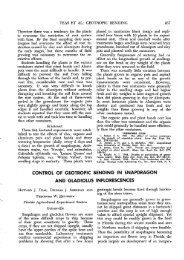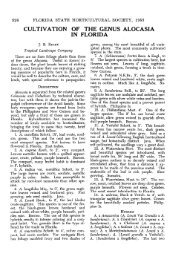(xanthosoma caracu, x. atrovirens and x. nigrum), ancient root
(xanthosoma caracu, x. atrovirens and x. nigrum), ancient root
(xanthosoma caracu, x. atrovirens and x. nigrum), ancient root
You also want an ePaper? Increase the reach of your titles
YUMPU automatically turns print PDFs into web optimized ePapers that Google loves.
Philippines because the tubers were larger, more<br />
mealy <strong>and</strong> mucilaginous <strong>and</strong> the people preferred<br />
the taste (13). In Venezuela, cocoyam production<br />
in 1960 was double that of 1937 <strong>and</strong> totaled 70,000<br />
metric tons. Half the crop was produced in the<br />
State of Sucre (1). Coursey writes that the cur<br />
rent rapid shift from taro to cocoyams in Africa<br />
(14) is apparently because the cocoyam is more<br />
suitable for manufacturing the popular food prod<br />
uct, fufu, a paste formerly made of yams (Dios-<br />
corea spp.) (19). The tubers <strong>and</strong> leaves form a<br />
major part of the diet of the people of Gabon (5).<br />
Speaking of Ghana, Karikari says: "Generally,<br />
cocoyams are not grown on a large scale. However,<br />
they are of immense importance <strong>and</strong> in every<br />
farm, garden or smallholding this crop is grown.<br />
The total acreage <strong>and</strong> annual production are there<br />
fore considerable . . . Because of its excellent<br />
storage quality, it is the one most often used as a<br />
travelling food by local people. When famine<br />
threatens, as it often does, cocoyam is the crop<br />
which is most frequently sought for to alleviate<br />
the situation. In fact, when people talk of famine<br />
in this country they refer primarily to a shortage<br />
of cocoyams." (31).<br />
In a consumer survey in Puerto Rico (1949-<br />
50), the majority of families preferred cocoyams<br />
over yams, sweet potatoes, plantains <strong>and</strong> green<br />
bananas (28). There is presently a shortage of<br />
cocoyams in Puerto Rico where the price has<br />
risen from 5tf per lb. in 1931 to 25tf in 1972. In<br />
the 1964-5 season, the Puerto Rican crop amounted<br />
to 17,700 tons valued at $2,620,000, mostly for<br />
domestic consumption with a small export to the<br />
United States (4).<br />
Propagation<br />
The plant top ("head" or maman) (56) may be<br />
used as planting material, or the underground<br />
MORTON: COCOYAMS<br />
stem (primary corm), whole (25) or cut into<br />
pieces, each piece with about 4 eyes (29). The<br />
primary corm has been found to give better,<br />
quicker growth <strong>and</strong> higher yields than the secon<br />
dary corms, or tubers, which are sometimes em<br />
ployed (2, 23). The top should be set lower in the<br />
ground than it was originally—about 32 to 40 in.<br />
deep—an(j its leaves are trimmed (53). Corms or<br />
pieces should be set 3 to 5 in. below the surface.<br />
A. <strong>atrovirens</strong> may be propagated from offshoots or<br />
by <strong>root</strong>stock division (29). A. jacquinii is grown<br />
from suckers (58). Requirement of tops per hec<br />
tare may be 8,000 to 10,000 (17) or 10,000 to<br />
15,000 (53) depending on spacing.<br />
Culture<br />
Cocoyams thrive up to an altitude of 5,000 ft.<br />
in tropical <strong>and</strong> near-tropical zones (29). For best<br />
growth, the soil should be porous, rich in humus.<br />
In Florida, plantings have been successful on lowlying<br />
marl but good crops have also been obtained<br />
on scarified oolitic limestone (7). The plant has<br />
a high moisture requirement but needs less water<br />
than taro <strong>and</strong> better drainage.<br />
Spacing of 4 x 4 ft. has been recommended in<br />
good soil; 3 ft. x 3 ft. in poor soil. In Puerto<br />
Rican tests, a population of 7,260 plants per acre<br />
produced 75% more than 4,840 per acre <strong>and</strong> the<br />
yield increased with density up to 14,520 plants<br />
per acre (2). However, in Nigeria, Enyi reports<br />
that increasing spacing to 5 ft. x 5 ft. stepped up<br />
the yield, particularly when secondary corms were<br />
used as setts (23).<br />
Ideal planting time is said to be generally in<br />
Fig. 7. Xanthosoma jacquinii at the Fairchild Tropical<br />
Garden, Miami, Fla. This stout-stemmed species is favored<br />
as an ornamental <strong>and</strong> is important for pig feed in Puerto<br />
Rico.<br />
—Photo by Julia Morton.<br />
89





